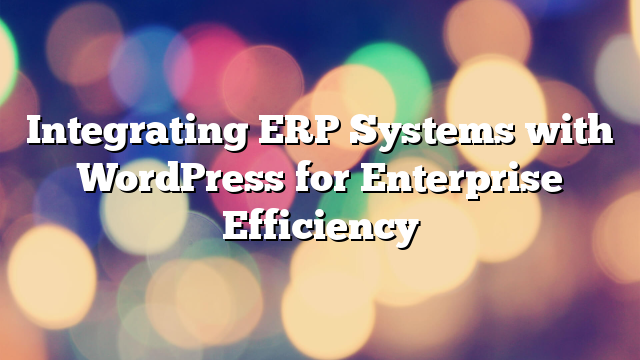Integrating WordPress with Next.js for Enterprise-Level Performance and Flexibility
08.01.2025

When it comes to building modern, scalable websites for enterprises, developers are increasingly looking for a combination of powerful tools that can deliver exceptional performance and flexibility. One such combination is integrating WordPress with Next.js, a React framework designed for speed and scalability. In this article, we’ll explore the advantages of using WordPress and Next.js together, and how this powerful duo can help businesses scale their digital presence while offering superior user experiences.
What Makes WordPress and Next.js a Perfect Match?
WordPress is a powerful content management system (CMS) that’s widely used for everything from small blogs to large-scale enterprise websites. It excels at content management, SEO optimization, and ease of use. However, when it comes to performance and flexibility, traditional WordPress themes may not be sufficient for modern, high-traffic websites. This is where Next.js comes in.
Next.js is a React-based framework that focuses on performance by offering features such as server-side rendering (SSR), static site generation (SSG), and automatic code splitting. It’s ideal for enterprises looking to optimize the speed and responsiveness of their websites while providing a seamless user experience. By combining WordPress as the backend CMS with Next.js as the front-end framework, businesses can achieve both content management power and top-tier performance.
1. Improved Website Performance with Next.js
For large enterprises, website performance is non-negotiable. Slow load times can negatively affect user experience, conversion rates, and SEO rankings. Next.js provides built-in optimizations that can significantly boost your website’s performance. Some of the key features include:
- Server-Side Rendering (SSR): Next.js allows content to be rendered on the server, ensuring faster load times and better SEO, as the fully rendered HTML is served to search engine crawlers.
- Static Site Generation (SSG): By generating static pages ahead of time, Next.js ensures faster load times, reduced server load, and improved user experience, particularly for pages that don’t change often.
- Automatic Code Splitting: Next.js automatically splits the JavaScript code into smaller chunks, ensuring that users only download the code necessary for the page they are viewing, which further optimizes performance.
When combined with WordPress, Next.js helps deliver an experience where content is fetched dynamically via the WordPress REST API or GraphQL, while rendering the front-end pages at lightning speed.
2. Flexibility to Build Custom User Interfaces
While WordPress provides a great deal of flexibility in terms of content management, its theme and plugin system can sometimes limit customization possibilities for the front-end. With Next.js, you get complete control over your front-end design and user interface. As a developer, you can use React components, hooks, and other features to create highly interactive and dynamic user experiences.
Next.js also supports server-side rendering, so users get fast, SEO-friendly pages without compromising on dynamic interactivity. Whether you’re building a highly customized homepage, product pages, or custom features for a specific business need, Next.js lets you control every aspect of the front-end while leveraging WordPress’s robust CMS capabilities on the back-end.
3. Seamless Integration with WordPress via the REST API
The core of the integration between WordPress and Next.js is the WordPress REST API. The REST API allows Next.js to communicate with WordPress and fetch content dynamically. This allows you to use WordPress as a headless CMS, managing content without having to worry about the limitations of traditional WordPress themes.
By using the REST API, content is fetched and displayed by Next.js in real-time, meaning that updates to the WordPress back-end are instantly reflected on the front-end. This also gives you the ability to manage and display content on various platforms (e.g., websites, mobile apps, IoT devices) without duplicating the effort.
Moreover, the REST API gives developers flexibility when it comes to fetching custom data, integrating third-party APIs, and extending the functionality of the website with additional features.
4. Better Developer Experience
Developing with Next.js paired with WordPress offers an improved experience for developers. While WordPress has traditionally been based on PHP, Next.js is built on JavaScript and React, two of the most popular and versatile technologies in modern web development. By combining the strengths of both technologies, developers can leverage a wide range of tools, libraries, and frameworks to streamline development processes.
Next.js provides features like hot reloading, automatic code splitting, and a flexible routing system, which improves productivity during the development phase. Additionally, the React ecosystem offers a wealth of reusable components and community-driven solutions, which further speeds up development time. With these tools at their disposal, developers can focus on creating high-quality, user-friendly applications without the overhead typically associated with traditional WordPress development.
5. SEO Benefits of Combining WordPress and Next.js
SEO plays a critical role in the success of enterprise websites, and Next.js provides several built-in SEO optimizations. For one, server-side rendering ensures that search engines can crawl fully rendered HTML pages, which improves the visibility of your content in search results. In addition, Next.js allows for the creation of clean, SEO-friendly URLs and metadata, which is crucial for ranking on search engines.
WordPress, with its extensive plugin ecosystem, is known for its SEO capabilities. Integrating WordPress with Next.js means that you can combine the best of both worlds: WordPress’s SEO-friendly features, like easy content management and on-page SEO optimizations, with Next.js’s performance and speed. This synergy results in websites that are both fast and SEO-optimized, which can significantly improve your search engine rankings and overall online visibility.
6. Scalability for Growing Enterprises
As enterprises grow, so do their digital needs. WordPress, while excellent for managing content, can encounter scalability issues when dealing with large amounts of data and high levels of traffic. However, by integrating WordPress with Next.js, you get the scalability of Next.js’s static rendering and server-side rendering capabilities combined with WordPress’s flexible content management system.
Next.js allows for easy caching and optimized delivery of static content, which helps handle traffic spikes and ensures that your site remains fast even during high-demand periods. Meanwhile, WordPress can continue to manage content in a simple and organized way. Together, these technologies provide a robust, scalable solution that can handle the needs of enterprises both today and in the future.
Conclusion
Integrating WordPress with Next.js offers a modern, scalable, and high-performance solution for building enterprise-level websites. By combining the flexibility and power of WordPress with the speed and interactivity of Next.js, enterprises can deliver seamless user experiences, improve SEO, and scale their websites as their business grows. Whether you are looking to optimize your website’s performance, enhance flexibility, or future-proof your digital strategy, this integration offers the best of both worlds.
If you’re interested in exploring how to integrate WordPress with Next.js for your enterprise website, contact AllWebDev today to get expert advice and custom solutions tailored to your business needs.



